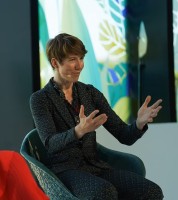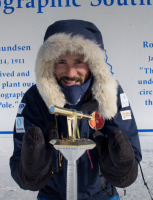Addressing the gaps in the current knowledge on geohazards in Southeast Asia Pr. Kerry Sieh

To ensure the translation of research results directly into practical applications for populations at risk, Prof. Kerry Sieh helped AXA and the Nanyang Technological University (NTU) design the AXA Chair on Natural Hazards at the Earth Observatory of Singapore, a long-term successional position which Prof. Sieh is the first to hold. Researchers under the AXA Chair are working on understanding the controls, evolution and probabilities of geohazard-related events and developing ways to monitor and forecast geophysical activity in the region. Among the most telling examples of their projects is a multi-hazard assessment in Thailand that will increase disaster resilience in key tourist destinations. Another is an evaluation of Singapore’s earthquake risk that will yield probabilities important for the insurance sector and recommendations for seismic building codes, non-existent in the country today.
Numerous, significant contributions
Created in 2009, the Earth Observatory of Singapore has already made numerous, significant contributions to the research community. On earthquakes, Prof. Sieh's team members have, for instance, made progress understanding large fault ruptures, and mapped out historical and modern incidences, as well as the patterns and likelihood of their occurring again. For tsunamis, too, they have identified recurrence characteristics, and their research on the Sunda Arc subduction system, the convergent boundary between the East Eurasian plates,has produced a body of work receiving attention from the international research community.
Their work on volcanoes has also contributed to increasing understanding about the behaviour of the region's 500 volcanoes known to have erupted in the last 10,000 years. EOS researchers have developed more complete knowledge of the way different types of volcanoes evolve toward eruption. They have also created a pioneering tool to provide probabilistic estimates for eruption forecasts, called WOVOdat.
On the subject of climate change and the sea-level rise it will induce, the EOS has established two labs to investigate the paleoclimate of Southeast Asia and its implications for the future. Another lab studies atmospheric pollution, and a fourth seeks out clues about tsunamis and typhoons in coastal sediments.
Impact-focused projects
Adding to these government-funded research ventures, AXA is funding impact-focused projects that answer practical questions. Among these are investigations that would not typically be compelling for academics, yet are supremely important to other fields. For example, one looming question is whether a big earthquake could occur beneath Singapore. The issue is crucial to the financial world, given the city-state is ranked among the top financial centers in the world. The project will produce concrete numbers—like the probability of a magnitude 5 quake within 30 kilometerrs of Singapore—that will be very important for the insurance industry.
In Phuket, Thailand, which suffered many deaths in the 2004 tsunami, post doctorates from the AXA chair are conducting a multi-hazard assessment. This region is also at risk for earthquakes, but has not experienced any within collective memory, leaving ample time to forget the threat. Working with stakeholders from government, the private sector and civil society, results here are being translated into concrete risk-planning and preparedness efforts for residents to increase their safety, for example, by improving the resilience of their buildings.
EOS researchers associated with the AXA Chair have also turned their attention to seafloor geodesy— measuring the shape and deformation of the ocean bottom. A challenge for the research community trying to understand powerful subduction zone earthquakes is that these zones are underwater, so taking GPS measurements of the sea floor requires a sort of acoustic relay at the surface. Japan is doing work like this, but the research vessels needed to make the rounds of the surface sensors can cost $50,000 a day. Instead, the EOS team is developing wake gliders – like small, self-propelled surfboards – that could do the same job for 50 to 1,000 times less.
Giving direction to geohazard research
In contrast to the more typical academic approach, where the work may end with the publication of a paper, the type of support and follow-up that the AXA Chair brings to EOS projects promises to have a great impact on the populations concerned. The AXA/EOS team will not only deliver the science, but help local actors interpret it and put plans into action. The project to assess the tsunami and earthquake risks in Phuket, for instance, will yield guidelines for local hotels, businesses and visiting tourists, helping to increase resilience and the safety of the people.
In addition to carrying out projects that bring relevant research results into the communities at risk, the AXA Chair on Natural Hazards has had other impacts on the EOS and its host institution, Nanyang Technological University (NTU). Primarily, the AXA Chair has helped give weight to the institution, as well as to its vital fields of research. The association with a large, international company has encouraged the Singaporean government in its decision to back the initiative and provided the institute with more political leverage. For instance, Prof. Sieh is confident that the Singapore earthquake risk project will significantly affect how the country views this hazard, which, in the future, will promote the inclusion of seismic provisions in its national building codes.
But one of the most important impacts for NTU of the AXA support is the Asian School of the Environment (ASE), created by Prof. Sieh. “In the long run, this could be our most important contribution and the AXA Chair is responsible for this,” he says. The first institution to offer undergraduate studies in the earth sciences in Singapore, the school is attracting the most highly qualified students and producing future government workers, insurers, teachers, etc., who will understand the nature of geohazard risk.


